Esports is no longer just an after-school hobby or a niche activity for gamers — it has become a global movement in education. In 2025 and 2026, schools across the world are actively integrating esports programs into their curriculum and extracurricular offerings. These initiatives combine digital literacy, teamwork, career skills, and student engagement in a format that aligns with modern student interests.
From middle schools to universities, esports in schools has evolved into a structured and respected domain, complete with varsity teams, academic credit, coaching staff, and even scholarships. With the global esports market projected to surpass $5 billion in revenue, educational institutions are recognizing the opportunities not only for competition but also for learning, career development, and community building.
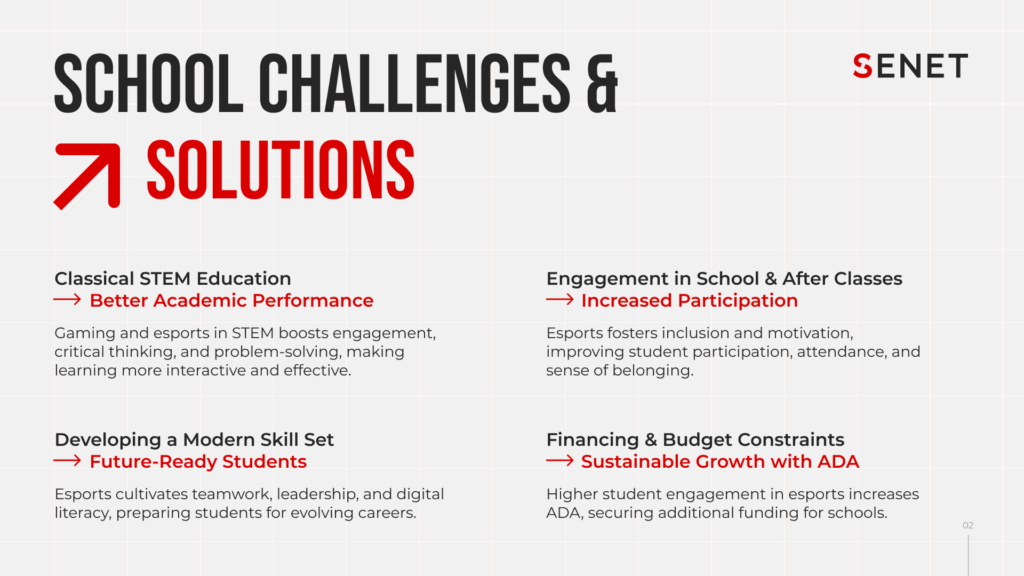
Why Esports Belongs in Schools
There are several compelling reasons why esports is gaining momentum in educational settings:
- Student Engagement: Esports appeals to students who might not participate in traditional sports or clubs. It creates a sense of belonging and excitement.
- STEM Integration: Competitive gaming introduces students to coding, network engineering, game development, digital art, and data analytics.
- Soft Skills Development: Through esports, students learn communication, leadership, teamwork, time management, and resilience.
- Career Pathways: The esports ecosystem supports roles in marketing, event management, broadcasting, coaching, and IT — all of which are relevant beyond gaming.
- Inclusion and Accessibility: Esports offers a low-barrier entry point for students of different backgrounds, skill levels, and physical abilities.
By 2026, esports is seen not as a distraction from learning but as a powerful educational tool that meets students where they already are: online, competitive, and digital-first.
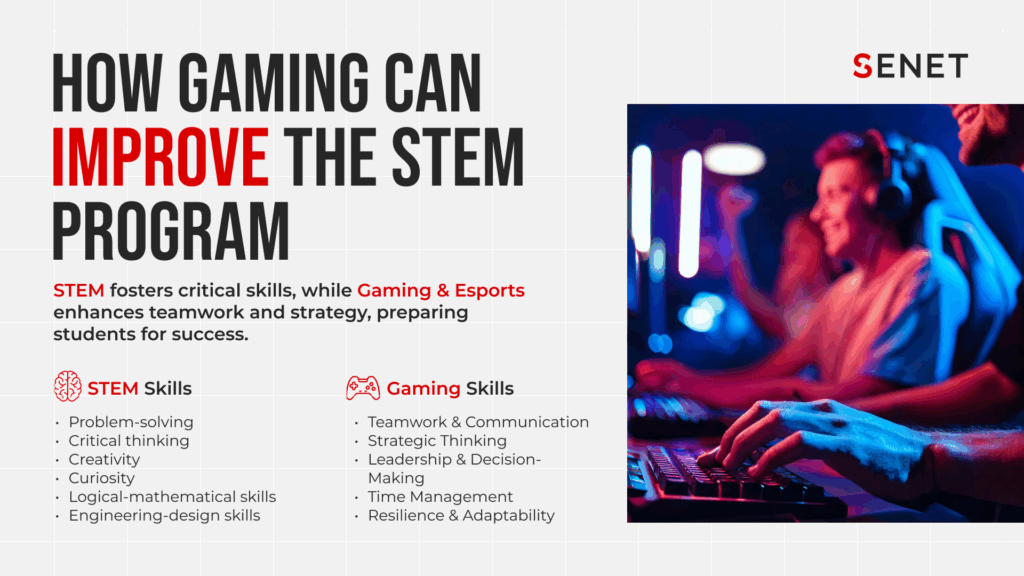
Esports Curriculum and Class Integration in 2026
Modern esports programs go far beyond letting students play games after school. Many institutions are embedding esports into official course offerings. Examples of esports-based classes include:
- Game Strategy and Analysis: Teaches critical thinking, tactical decision-making, and data-driven review of gameplay.
- Esports Management: Covers event planning, team logistics, budget management, and sponsorships.
- Content Creation: Students learn video editing, livestreaming, podcasting, and social media branding.
- Health and Performance: Classes on physical wellness, mental health, reaction time training, and digital wellbeing.
Schools partner with organizations like NASEF (North America Scholastic Esports Federation), HSEL (High School Esports League), and regional educational bodies to build curriculum frameworks that are both engaging and standards-aligned.
How to Start an Esports Program in Schools: From Equipment to Team Building
Step 1: Gaining Administrative and Community Support
Before launching an esports program, schools must first gain buy-in from leadership, faculty, and parents. In 2025, this is easier than in previous years thanks to growing public awareness of esports’ educational value.
Key talking points for approval include:
- Esports builds the same skills as traditional sports: leadership, communication, and collaboration.
- The program can align with existing academic objectives (STEM, digital media, wellness).
- Esports scholarships and university pipelines are widely available.
- Modern programs promote healthy screen time, mental health, and sportsmanship.
Hosting an info session or pilot event can help showcase the positive potential to stakeholders.
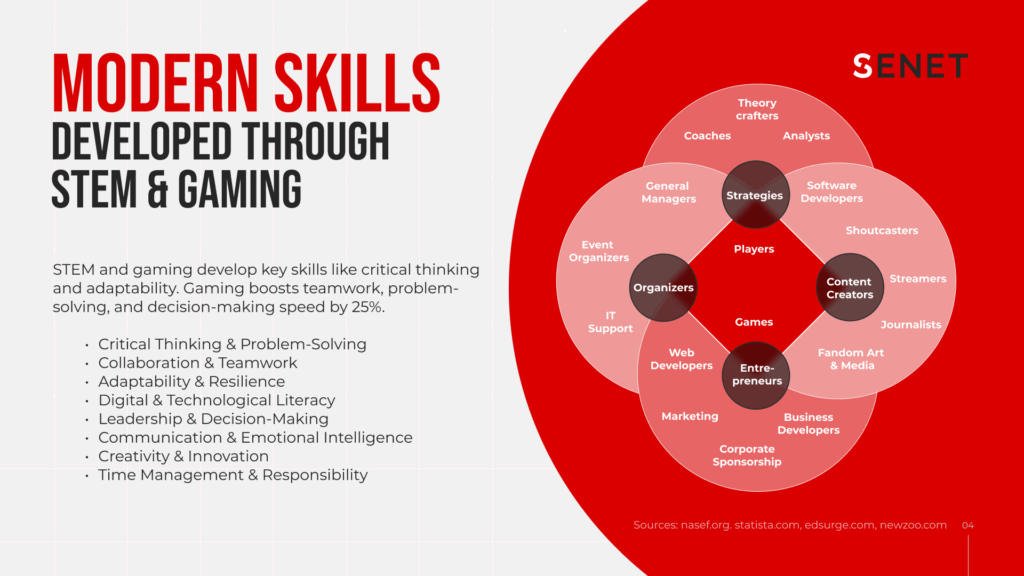
Step 2: Choosing the Right Games for Schools
Selecting age-appropriate, team-based titles is critical. In 2025, these are some of the most common esports titles in school environments:
- Rocket League – physics-based 3v3 soccer game that’s easy to learn and non-violent.
- League of Legends – strategic 5v5 MOBA with professional-level team mechanics.
- Valorant – team-based tactical shooter with clear communication roles (used mostly in high school and up).
- Overwatch 2 – hero shooter with role-specific teamwork.
- Minecraft (Education Edition) – often used for creative competitions and collaborative challenges.
Game selection should reflect school values, student demographics, and tournament availability in your region.
Step 3: Equipment and Lab Setup
An esports program doesn’t need a stadium to get started, but a basic lab setup is important. In 2025, the ideal school esports lab includes:
- 6–12 mid-range gaming PCs or laptops (with GTX/RTX or equivalent GPUs)
- 144Hz monitors for smoother gameplay
- Mechanical keyboards and gaming mice
- Reliable wired internet or LAN setup
- Voice communication tools like Discord (managed with age-appropriate moderation)
- Video streaming and VOD review software (OBS, Streamlabs, Insights.gg)
Smaller schools can start with just a few stations, with students rotating during practice. Some even use cloud gaming or bring-your-own-device models to reduce costs.
Step 4: Coaching, Mentorship, and Team Roles
A great esports team needs more than just skilled players — it requires structure. Most school teams include:
- Coach – a teacher, tech specialist, or outside mentor who facilitates practice, discipline, and learning.
- Team Captain – a student leader who coordinates strategy and sets an example.
- Support Roles – students in charge of social media, event coordination, or shoutcasting.
Professional development programs now exist to help faculty become certified esports coaches. Many also collaborate with local colleges or community centers for mentorship.
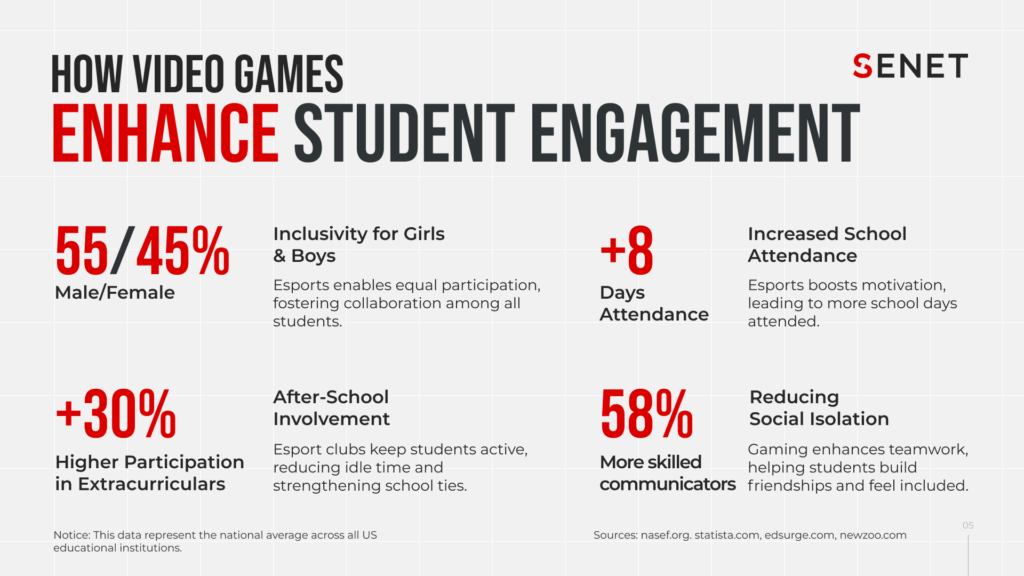
Step 5: League Participation and Events
To provide structure and goals, schools should register with regional or national esports leagues. Some of the largest platforms include:
- NASEF – offers free leagues, curriculum, and mentorship support.
- PlayVS – partners with state athletic associations for official high school competition.
- HSEL – runs paid competitions with seasonal championships.
- Esports Ohio, Garden State Esports, and others – state-specific leagues with strong community ties.
Schools can also host local LAN events, scrims, or charity streams to involve parents and students outside the core team.
Academic, Mental, and Career Benefits of Esports in Schools
Boosting Academic Performance and Engagement
Contrary to old stereotypes, students involved in esports are more likely to stay engaged with schoolwork. Programs that integrate gaming with learning have shown improvements in:
- Attendance rates – Students involved in teams have a reason to show up consistently.
- GPA maintenance – Many programs require academic eligibility, which motivates students to keep grades up.
- Cross-subject interest – Esports often sparks curiosity in STEM, business, health science, and creative writing.
In 2025, some schools also use esports data (like match stats or shot accuracy) in math lessons or allow students to write strategy guides in English class. This practical application makes learning more relevant and exciting.
Supporting Mental Health and Student Well-being
Esports can offer emotional and psychological support to students — especially those who feel disconnected from traditional school culture. Key benefits include:
- Social inclusion – Teams create peer networks for students who may not thrive in other activities.
- Safe emotional expression – Games allow players to work through stress and improve self-confidence in a controlled environment.
- Stress management – When guided by mentors, students learn how to cope with pressure, communicate under stress, and de-escalate conflicts.
Leading programs incorporate wellness training, emphasizing screen-time limits, posture, hydration, sleep, and stress reduction. Some even partner with school counselors to identify at-risk students early through behavioral patterns in-game.
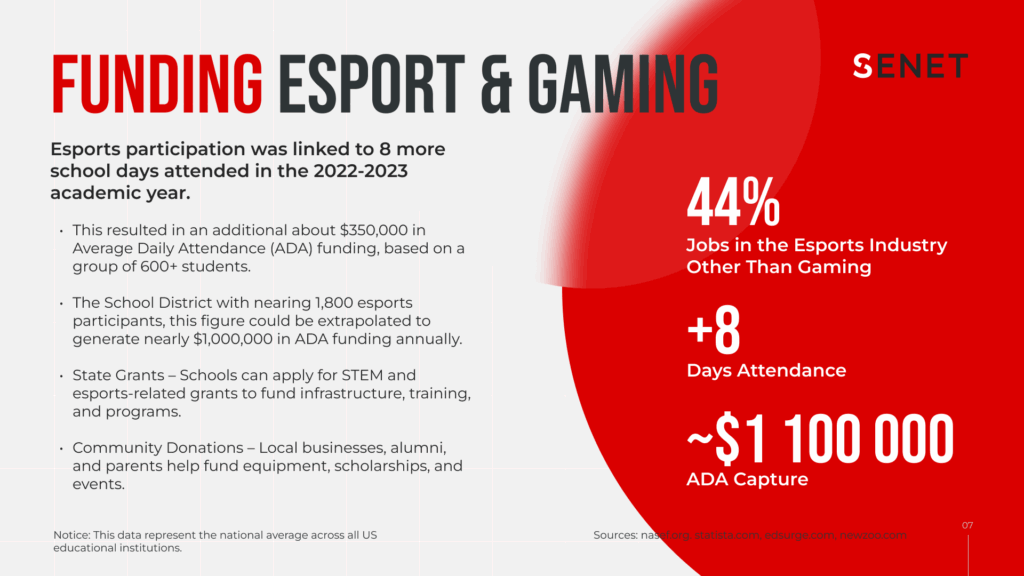
Developing Career Skills Through Esports
Esports is a gateway to a growing number of digital careers. Students involved in scholastic programs gain real, marketable experience in:
- Game design and software development
- Content creation and video editing
- Event planning and logistics
- Digital marketing and social media
- Coaching, analytics, and player development
By 2025, over 100 colleges in the U.S. alone offer esports scholarships — many of which are available to students pursuing not only gameplay but roles in production, tech support, or business.
In some school districts, esports participation is included in formal career and technical education (CTE) pathways. Students graduate with portfolios, internship connections, and even esports-specific certifications.
Tracking Impact and Proving Value
To sustain and grow esports programs, schools often collect data to demonstrate positive outcomes. Key metrics include:
- Participation rates across demographics
- GPA comparisons of players vs. general population
- Reduction in behavioral incidents
- Increase in STEM or tech pathway enrollment
- Number of college esports scholarships or media job placements
This data can be presented to school boards, grant funders, or local governments to secure additional support and budget allocation.
The Future of Esports in Schools: AI, VR, National Leagues, and Smart Infrastructure
Emerging Technologies Transforming Esports Education
In 2025, the integration of AI, virtual reality (VR), and cloud-based infrastructure is taking esports programs in schools to the next level. These innovations are helping schools personalize training, automate operations, and prepare students for tech-centric futures.
Artificial Intelligence is now used to track student performance, suggest drills, and analyze gameplay without manual input from coaches. AI assistants help students identify weak spots, learn new tactics, and get real-time feedback during practice.
Virtual Reality (VR) labs are being introduced in STEM-focused schools, enabling immersive simulations for both competitive games and training exercises. Students learn how to cast, coach, or even develop for VR-based esports titles.
Wearable tech and biometrics allow schools to monitor stress, eye movement, and reaction time — giving teachers and wellness counselors new tools to support students’ health and focus.
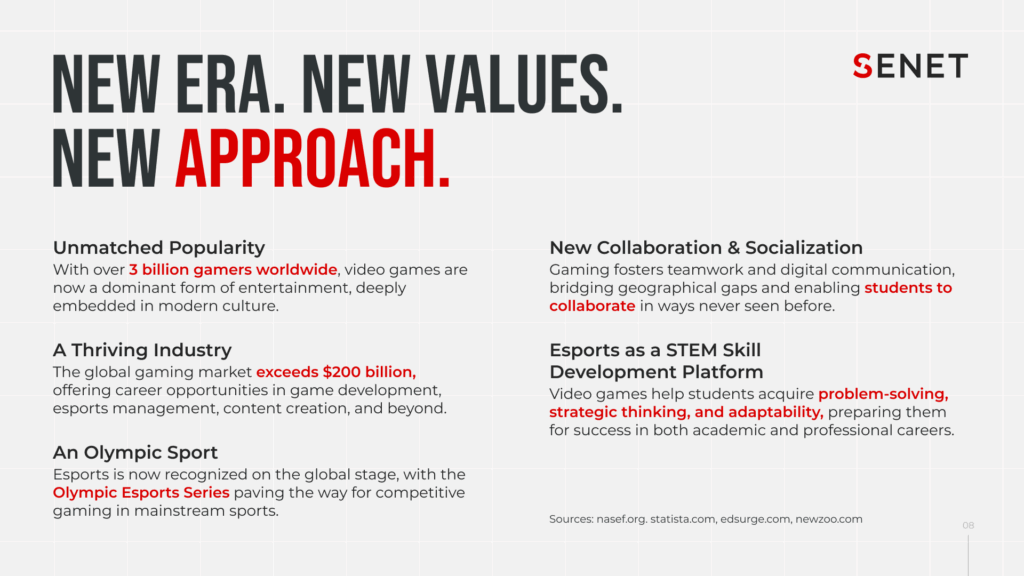
The Role of SENET in School Esports Infrastructure
As schools grow their esports programs, managing hundreds of devices, updates, user access, and game licenses becomes complex. That’s where SENET — a smart gaming management software — makes a real difference.
SENET allows schools to:
- Centrally manage multiple gaming PCs and accounts from the cloud
- Schedule esports lab sessions without manual tracking
- Pre-install and update games remotely
- Set time limits and access rules for student safety
- Collect usage data to measure engagement and optimize schedules
Thanks to its flexibility, SENET works across various setups — whether it’s a single high school lab or a district-wide program with multiple esports rooms.
Schools that use SENET reduce the workload on IT staff and ensure consistency across all gaming devices. For educators, that means more time focusing on teaching and coaching — and less time troubleshooting.
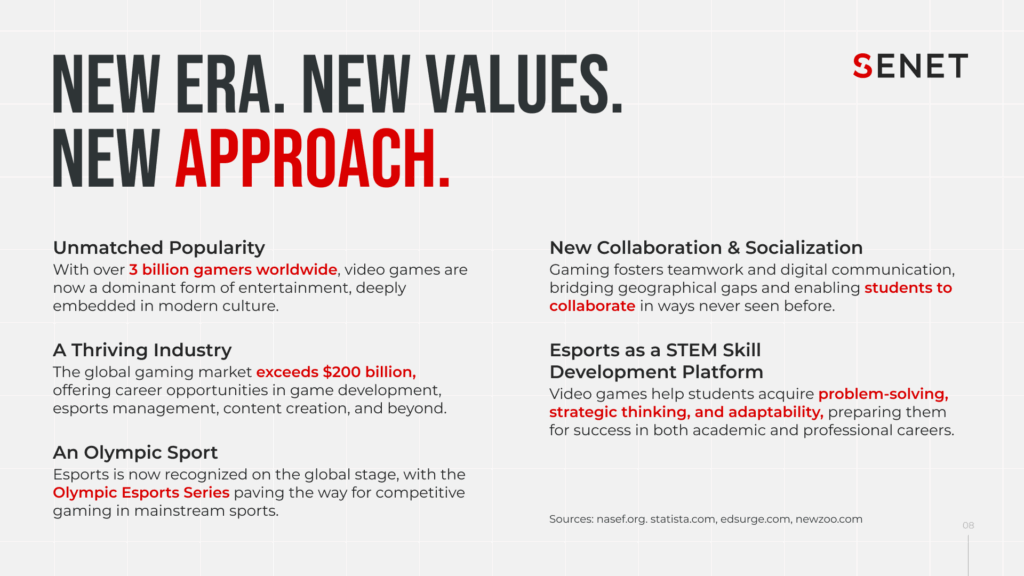
National Leagues and the Road to Professional Play
National scholastic leagues continue to grow in 2025. School teams now participate in:
- State-run championships
- Inter-district LAN tournaments
- Online invitationals with international partners
Platforms like PlayVS and NASEF offer structured seasons with playoff brackets, live broadcasts, and scholarship awards. SENET can be integrated with these ecosystems to streamline event management and player readiness.
As more students participate, high schools are forming scouting relationships with collegiate programs. Some even align with professional esports organizations to create “path-to-pro” models, similar to traditional athletics.
The Broader Impact of Esports in Schools
Esports is reshaping how students see themselves. It gives gamers a chance to be recognized not just for playing, but for leading, building, creating, and excelling.
In a world where digital skills are foundational, esports is a powerful entry point. With tools like SENET, schools can manage this transformation effectively and sustainably.

